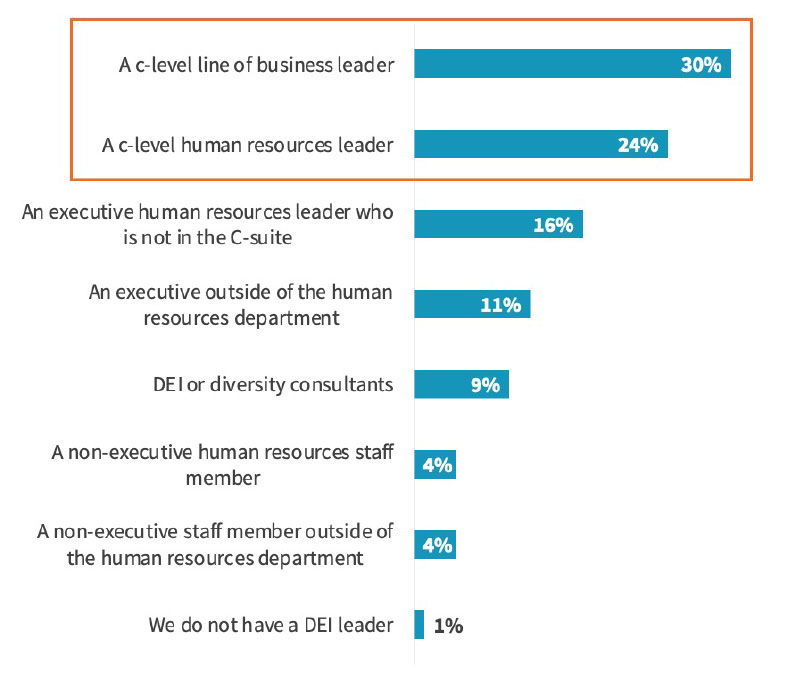Investing in a mature Diversity, Equity, and Inclusion (DE&I) program has proven to put organizations ahead of their competitors in innovation, time to market, and other positive business performance indicators. To maximize those benefits, it is important to understand who must drive, support, and empower DE&I business strategy.
Research shows that a partnership between human resources and other parts of the business is most effective, particularly when DE&I efforts are either co-led by HR and other parts of the business or when HR leads the strategy with a significant amount of input from other parts of the business.1 It is also important that leadership comes from the C-suite, which is a common characteristic of companies that are most mature in achieving their desired DE&I outcomes.
Overall, 54% of organizations surveyed said either a business leader or HR leader at the C-level heads their organization’s DE&I program, according to research AWS commissioned TechTarget’s Enterprise Strategy Group (ESG) to conduct, as shown in Figure 1:2
Figure 1: Who leads your organization’s DE&I program?
For companies at the highest end of the DE&I maturity model created by ESG and AWS,3 C-level leadership is even more pronounced, with 70% of respondents saying their organization’s DE&I efforts are led by a C-suite business or HR leader.
High-level support for DE&I is critical. When asked to name the biggest challenges to DE&I success in their organizations, 26% of business leaders cited lack of buy-in from executives.
A Mature Approach to Diversity, Equity, and Inclusion Delivers Real Results
Read this paper to learn how enterprises foster mature DE&I programs and the business impacts their efforts drive.
Download NowExecutive support plays out in a number of ways. For example:
- Companies at the highest end of the maturity model place a higher priority on frequent communications about DE&I and about the organization’s broad business strategies and goals.
- Companies with more mature DE&I strategies are more likely to have initiatives co-led by HR in partnership with other parts of the business.
- A more mature DE&I approach is facilitated by frequent feedback from line-of-business leaders to the HR team.
A more mature approach also involves setting specific, qualifiable DE&I goals and making senior leadership both accountable and incentivized to achieve them. The majority of companies already report DE&I outcomes to the C-suite and board. They also tie performance and compensation into achieving DE&I goals and outcomes, as shown in Figure 2.
Figure 2: Does your organization do any of the following to incentivize achievement of DE&I goals?
As you might expect, accountability and incentives are highest among the companies that are the most successful and mature in meeting their DE&I objectives. Among companies at the highest end of the DE&I maturity model, 69% reported DE&I outcomes and goal achievements to the C-suite and board. In addition, 65% said they use DE&I outcomes to influence performance evaluations and compensation of C-suite executives, 62% for HR leaders, and 59% for line-of-business managers.
Who is in charge and who is accountable matter. When leadership comes from the top, it sets an agenda for the rest of the organization. When leaders are compensated and held accountable for the success of their DE&I programs, their organizations have better outcomes—from improving ROI, to hiring and retaining better people, to increasing market share and competitive advantage. Please review the articles and resources on this site to learn more about how your organization can maximize the benefits of DE&I to achieve these outcomes.
1“A Mature Approach to Diversity, Equity, and Inclusion Delivers Real Results,” TechTarget’s Enterprise Strategy Group Research Insights report commissioned by AWS, March 2023
2 Ibid.
3 Ibid.

